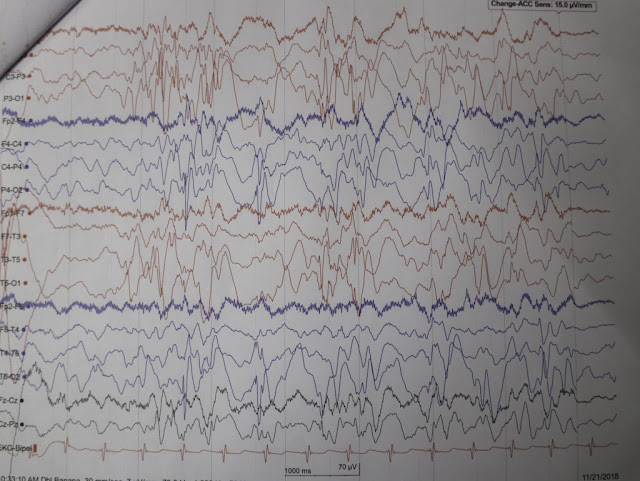These are the Electroencephalographic record of the brain of two children, who are seven years old.
The first one is of a child who is restless, hyperkinetic, and disruptive in the class room. He cannot sit at one place or focus on an activity beyond a few minutes. He was being considered by the school to discontinue him from the school when the family came to visit us in the department of Developmental Paediatrics and Child Neurology.
The second child is too seven years, who often quarrelled with other children including being physical. He was indifferent to the instruction of the teachers. At home, she would quarrel with her younger brother. Her sleep initiation was difficult and woeful get up a few times at night.
Both these children did show an altered electric rhythm of the brain in the electroencephalographic record.
Having observed for eight weeks and seeing no improvement after modifying the sleep pattern, and the repeat electroencephalographic record showing similar findings, both children was prescribed medicines to restore the electric rhythm disturbance.
It is now about six months since then. Both children returned last week, with remarkable improvement in behaviours attention and self regulation.
These are just two children, out of about 60children in 2018 who received a similar treatment with about 80 percent of them indicating noticeable changes in behaviour in the first nine months.
Let me suggest that the dysrhythmic activity of the brain alters human behaviour at least in children. I usually wait for the repeat electroencephalographic record after nine months of commencement of treatment to be categorical on this matter.
It is my experience that sleep disturbance, attentional deficit, disruptive behaviour, lack of self regulation with high level of impulsivity are some indications in the disturbance in the electrical rhythm of there brain. It is the elctroencephalogram, which would reveal this.
Having been involved with hundreds of children during the last twenty seven years since I first noticed this association between brain and behaviour, it is now usual for me to rely on the electroencephalogram, usually taken at an interval of two months to decide whether children with behavioural disorders would need treatment to regularise the electrical dys-rhythm of the brain.
To me this has been a path finding discovery about other symptoms of disturbance in the brain, other than convulsion.
Brian and behaviour are closely related.
M.C.Mathew(text and photo)


No comments:
Post a Comment